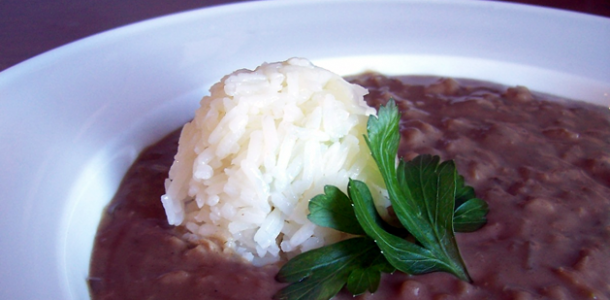- 3/4 cup all purpose flour
- 3/4 cup vegetable oil
- 1 cup shallots, finely chopped
- 2 stalks celery, finely chopped
- 1 medium carrot, finely chopped
- 4 cups shell fish stock (You can substitute chicken stock.)
- 4 tablespoons butter
- 1 cup dry white wine
- 1/4 cup Cognac or Brandy (optional see notes)
- 3 tablespoons minced parsley
- 1 large bay leaf
- 1/2 teaspoon freshly ground black pepper
- 1/4 teaspoon cayenne pepper
- 1 pound lump crabmeat
- 1 1/2 cups heavy cream
- Kosher salt and fresh ground black pepper to taste
- 4 cups cooked long grain white rice
Creole Crab Bisque is a dish that can be found in most of the finest restaurants in New Orleans. By 1724, the roots of Creole cuisine had been laid as the city of New Orleans began to grow and take its position as one of the most important possessions in the New World. Unlike Cajun cuisine, Creole cooking was developed in a city that maintained close European contact. As New Orleans and its population gained affluence, they came to enjoy households with staffed kitchens and restaurants with remarkably sophisticated dining rooms, a few of which still survive today. In New Orleans, as in France, having a good cook was crucial to one’s social status.
By 1840, New Orleans was the fourth largest city in the United States, the second largest port, and an economic center that attracted businessmen from all over the world. It was one of the first cities in the country to have public restaurants. Antoine’s, America’s oldest restaurant under single-family ownership, was founded in 1840 and it is here that we first encounter the Creole Crab Bisque.
This dish calls for a roux. Roux is the base for many Louisiana dishes, more notably gumbo, but also stews, bisques and more.
There are three basic types of roux: light (or “blond”), medium (or “peanut butter” color), and dark (a “chocolate” color). For gumbos, Creole cooks tend to prefer a blond or a medium roux, where Cajun cooks tend to prefer a very dark roux, which has a wonderful, almost nutty flavor. There are, of course, exceptions to this. In fact, you’ll see people making many different “levels” of roux. Blond, light brown, medium-light brown, medium brown and dark browns that range from the color of milk chocolate to the color of bittersweet chocolate.
Roux must be stirred constantly to avoid burning. Constantly means not stopping…period. It takes almost no time to burn a roux if stirring stops. If you see black specks in your roux, you’ve burned it; throw it out and start over. Be very careful not to splatter any on you. A cooking roux is extremely hot and it sticks to skin. They don’t call it Creole napalm for nothing.
Here we are going for a medium-dark roux. You’ll need to take it off the heat slightly before the roux gets to the color you want. The residual heat in the pan (particularly if it’s cast iron) will continue to cook the roux. I recommend cooking this in a 5-quart heavy Dutch Oven. I have an enameled cast-iron pot that is perfect for the job.
A note on adding brandy: There are several schools of thought on brandy in a Creole Crab Bisque. Traditionally, 1/2 ounce of brandy is served along side the bisque allowing the guest to add as much or as little as they like. We find this method in serving suggestions dating from 1868 and it imparts a most unique and individualized flavor. I’m a traditionalist in this respect and find that many guests are appreciative of the flavor and some, not at all. Many cooks will add the brandy at the same time other liquids are added, allowing it to mellow as the bisque base cooks. Finally, many cooks choose not to add it at all feeling that it competes with the delicate flavor of the crab.
Directions:
- Finley chop shallots, celery and carrots and set aside.
- Add flour and oil to a heavy 5-quart Dutch Oven and place over a medium heat. Stir constantly making sure to scrape evenly along the bottom and into the corners of a pot. You want to insure that the entire bottom of the pot is constantly turned over.
- Once the roux has reached a color depth a few shades darker than peanut butter, remove the pot from the heat and immediately add chopped shallots, celery and carrot while continuing to stir. This will quickly cool the roux and stop it cooking further.
- Return the pot to medium heat and add stock, wine, parsley, butter, bay leaf, black pepper, cayenne pepper and brandy (optional).
- Bring to a boil and then cover and lower heat to a simmer for 4 hours. You will need to watch closely and continue to add water to keep the level of liquid constant.
- After 4 hours, add crabmeat and bring back to a low boil for approximately 20 minutes.
- Stir in cream and return to a boil. Cut the heat, cover for 10 minutes and then serve in a bowl with rice.






I had to share this one. Looks amazing and
I will definitely be trying this soon. Thank you..
Skye Shipley Christian
Skye,
Thanks. I have to tell you, I try not to cook this at home too often because I’ll eat my weight in it. It’s on my short list of favorite foods ever. Enjoy!
Gregory